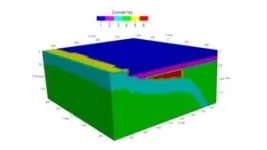(Press-News.org) Plate temperature and water release can explain the occurrence of different types of earthquakes in Guerrera, Mexico. The Kobe University simulation study also showed that the shape of the Cocos Plate is responsible for a gap where earthquakes haven’t occurred for more than a century. The results are important for accurate earthquake prediction models in the region.
Where one tectonic plate is pushed down by another, the resulting stress is released in various tectonic events. There are catastrophic megathrust earthquakes, unnoticeable “slow slip events,” and continuous low-frequency “tectonic tremors,” and knowing which occurs under which conditions is essential to predicting earthquake probabilities and thus preparing for disasters. Kobe University geophysicist SUENAGA Nobuaki says: “We are especially interested in gaps where earthquakes are less likely to occur, because we assume that there is some difference in physical conditions at the plate interface.” Being a specialist in three-dimensional computer simulations to understand the relationship between earthquakes, the temperature at the interface between the plates, and the role of water produced when rocks are transformed under great heat and pressure, Suenaga wanted to apply his experience to finding out what conditions create these distribution patterns.
His team also includes the Colombian research assistant Erika Moreno, who experienced a devastating earthquake in 1999 which also destroyed her family’s house. “I did not understand what was happening around me and so I decided to study Earth sciences to add to our knowledge about the nature of earthquakes,” she says, also mentioning that her studies led her from her home country via the National Autonomous University of Mexico to Kobe University for their pioneering research on computational modeling of earthquake mechanism.
Suenaga’s team thus focused on studying the Guerrero region of Mexico, explaining: “In this region there is a gap where no major earthquake has occurred in over a century, and the risk of one occurring in the near future is high and the expected damage is large. So we thought that the area is important.” However, computer models need to be verified by actual measurements, and the data usually used for this is not available in that area. “We introduced a new indicator that uses data obtained by ships, aircraft, satellites etc., and this made it possible to evaluate our model,” explains the Kobe University researcher.
His team published their results in the journal Scientific Reports, reporting three main findings. First, they were able to show that the temperature at the interface between the plates is a good predictor of the type of earthquake. Second, the seismic gap is caused by the specific shape of the plate in that area, which causes temperatures there to be lower than in the surrounding area. And third, water released from the transformation of the rock can explain the occurrence of slow slip events and tectonic tremors. “This study is the first to estimate the specific amount and location of that water and it revealed that the increased pore pressure from the water could reduce the stress between the plates, allowing them to slip more effectively. Thus, the Guerrero seismic gap can release strain energy through slow slip events,” says Suenaga. Simply put, this area is better lubricated.
However, other studies showed that slow slip events likely don’t release the stress in all parts, and in particular not in shallow parts of the plate, which is where megathrust earthquakes causing catastrophic damage occur. Suenaga explains, “Slow slip events are often seen as precursors of huge earthquakes and so it is important to understand the mechanism behind low slip events.” Moreno adds, “Our work is crucial because studying the way plates are pushed underneath others and the processes that occur as a consequence provides insights into the distribution of volcanism and the locations of earthquakes.”
One goal for this work is to help authorities to make better estimates of earthquake risks and thus improve preparedness. But Suenaga wants to generalize the results to other regions. He explains: “Since the tectonic background and underground structure are completely different depending on the region, it is very difficult to construct a single physical model that can explain earthquake phenomena everywhere. However, we hope to get closer to a universal numerical model by continuing to build models for various subduction zones and deepening our understanding of the physics of earthquake occurrence and modeling know-how.”
This research was funded by the Japan Society for the Promotion of Science (grant 21H05203). It was conducted in collaboration with researchers from the National Autonomous University of Mexico and the Chinese Academy of Sciences.
Kobe University is a national university with roots dating back to the Kobe Higher Commercial School founded in 1902. It is now one of Japan’s leading comprehensive research universities with nearly 16,000 students and nearly 1,700 faculty in 10 faculties and schools and 15 graduate schools. Combining the social and natural sciences to cultivate leaders with an interdisciplinary perspective, Kobe University creates knowledge and fosters innovation to address society’s challenges.
END
Mind the seismic gap: Understanding earthquake types in Guerrero, Mexico
2025-03-31
ELSE PRESS RELEASES FROM THIS DATE:
One hour’s screen use after going to bed increases your risk of insomnia by 59%, scientists find
2025-03-31
Scientists have found another reason to put the phone down: a survey of 45,202 young adults in Norway has discovered that using a screen in bed drives up your risk of insomnia up by 59% and cuts your sleep time by 24 minutes. However, social media was not found to be more disruptive than other screen activities.
“The type of screen activity does not appear to matter as much as the overall time spent using screens in bed,” said Dr Gunnhild Johnsen Hjetland of the Norwegian Institute of Public Health, ...
Canada needs to support health research at home and abroad
2025-03-31
In the face of major changes to federal policy and funding in the United States, Canada should support Canadian researchers with adequate funding to ensure long-term research in health and science, argue authors in two articles published in CMAJ (Canadian Medical Association Journal).
“As the US stands on the brink of tearing down its exemplary system for covering the full costs of research, Canada, with its flawed federal system for indirect costs, should heed the recent commissioned science policy report and a chorus of advocacy calling for an enhanced indirect cost system,” writes Dr. William Ghali, vice-president ...
Cannabis use disorder among insured pregnant women in the US between 2015-2020
2025-03-31
Cannabis use has been increasing during pregnancy, according to researchers at Columbia University Mailman School of Public Health and the Columbia University Irving Medical Center. Previous research has observed that past-month cannabis use has more than tripled among pregnant women in the U.S. from 2002-2020 with self-reported cannabis use rising from 1.5 percent to 5.4 percent over the 18 years of tracking data. The findings are published in the American Journal of Preventive Medicine.
Medical guidelines recommend that pregnant women abstain from cannabis because of its link to an increased risk of adverse maternal ...
Education system needs overhaul to support school anxiety, psychologists say
2025-03-30
The UK education system must urgently change to be more understanding of school ‘refusers’, as returning to school might not be the right outcome for some children, psychologists say.
While much has been made of school attendance figures in recent months, a group of experts are suggesting not enough attention has been given to the experiences of parents and young people experiencing school distress.
In a new book, What Can We Do When School’s Not Working?, a parent and two ...
Play “humanizes” pediatric care and should be key feature of a child-friendly NHS – report
2025-03-30
Play should be a core feature of children’s healthcare in forthcoming plans for the future of the NHS, according to a new report which argues that play “humanises” the experiences of child patients.
The report, by University of Cambridge academics for the charity Starlight, calls for play, games and playful approaches to be integrated into a ‘holistic’ model of children’s healthcare – one that acknowledges the emotional and psychological dimensions of good health, ...
Stricter oversight needed as financial misconduct drives risk-taking in banking
2025-03-30
Banks facing regulatory sanctions for financial misconduct tend to adopt riskier business practices, according to new research.
The authors warn repeated or systemic misconduct can accelerate risk-taking in ways that weaken both individual institutions and the wider financial system.
Researchers from the University of East Anglia (UEA), the US Department of the Treasury and Bangor University, in the UK, drew on data from nearly 1,000 publicly listed US banks from 1998 to 2023 - a period spanning multiple economic cycles including the 2007–09 ...
Cardiac arrest during long-distance running races
2025-03-30
About The Study: This study found that despite increased participation in U.S. long distance running races, the incidence of cardiac arrest during U.S. marathons and half-marathons remains stable. There has been a marked decline in cardiac arrest mortality, and coronary artery disease was the most common etiology among cases with sufficient cause-related data. Effective emergency action planning with immediate access to defibrillation may explain the improvement in survival.
Corresponding Authors: To ...
Preventable cardiac deaths during marathons are down, Emory study finds
2025-03-30
While more people than ever are running marathons in the U.S., the risk of dying from a heart attack during a run has fallen dramatically in recent years. That’s a key conclusion from a new study by Jonathan Kim, associate professor in the Emory School of Medicine. Kim’s research is a follow-up to a study he published in 2012 – the first investigation into unexpected cardiac arrests during long distance running events.
The new findings, published in JAMA, indicate that while the rate of marathon runners who suffer cardiac arrests remained unchanged, their chance for survival is twice what it was in the ...
New study finds peripheral artery disease often underdiagnosed and undertreated; opportunity to improve treatments, lower death rates
2025-03-30
A new Intermountain Health study finds that peripheral artery disease, a condition that affects more than 10 million Americans over the age of 40, is often underdiagnosed and undertreated, with fewer women getting guideline-directed medical therapy than men.
As a result, combined with this highly debilitating disease, patients with peripheral artery disease have a more than 50 percent chance of dying from the condition.
Peripheral artery disease affects nearly 10 percent of the US population. It occurs when the arteries that carry blood to the legs and arms become narrowed or blocked by plaque ...
Use of antidepressant medication linked to substantial increase in risk of sudden cardiac death
2025-03-30
Vienna, Austria- 30 March 2025
Sudden cardiac death (SCD) refers to an unexpected death of a person, believed to be caused by a heart-related issue. It occurs within one hour of the onset of symptoms in witnessed cases or within 24 hours of the person being last seen alive in unwitnessed cases.
The causes in people under the age of 39 are often a thickening of the heart muscle or an electrical problem with the heart. In older people, SCD is more likely to be caused by a narrowing of the blood vessels that supply the heart.
Previous research has shown1 that patients with psychiatric disorders have an increased all-cause mortality ...




